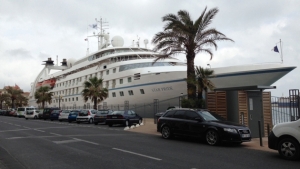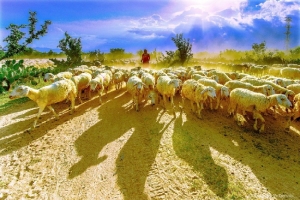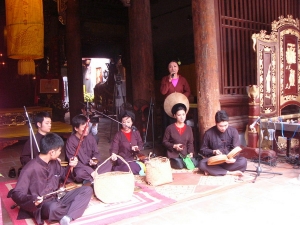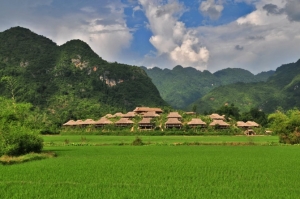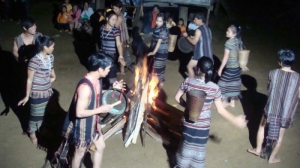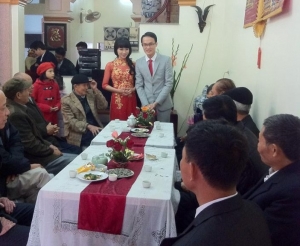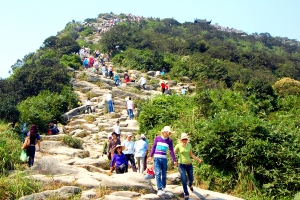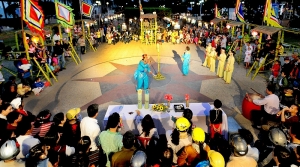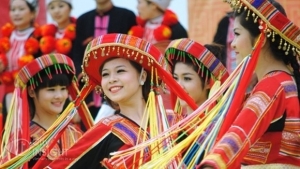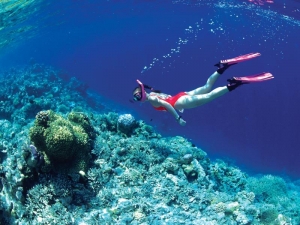
Asia Pacific Travel Team
Five-star cruise docked in Quy Nhon port
After landing, 60 tourists visited Cham temple towers in Tuy Phuoc district and Quang Trung museum in Tay Son district, while the remaining 40 vacationers toured Quy Nhon city with destinations such as the Binh Dinh museum, Twins Tower, and Long Khanh pagoda.
The Panama nationality cruise ship then continues its journey to Da Nang city and Ha Long Bay.
This is the third time the cruise ship has arrived at Quy Nhon port since December 29, 2014, bringing a total of 327 foreign visitors to the central coastal province.
In 2014, Binh Dinh welcomed over two million arrivals for the first time. The figure is forecast to increase considerably this year.
UNDER THE SUN
PHAN RANG BOASTS MANY HEADS OF SHEEP BUT THEY’RE NOT THE ONLY ATTRACTION IN THIS SUNBURNT LAND.
One day, when I was surfing on Facebook, I came across some images of thousands of sheep grazing on grass in a gaint open field. The caption said it was in Vietnam, which made me wonder whether there we actually had this many sheep in the country. The photos were beautiful and looked like they were taken somewhere alse.
So I decided to visit Phan Rang the following month, to see thousands of sheep on open green fields, not in some faraway land but in my homeland, Vietnam.
From Hanoi I flew to Dalat, stayed one night and in the morning, as the birds started to sing, rented a motorbike and headed to Dran Pass and Phan Rang on the coast.
It wasn’t too far, only around 120km, but the road was so good so I drove slowly to take in the clean fresh air on the zig-zag mountain road to Phan Rang, a land of sun and wind. Beyond Ngoan Muc Pass I could feel the temperature change as I descended, the air becoming warmer and little more uncomfortable.
Phan Rang, the capital of Ninh Thuan province, was formerly the Champa Kingdom’s ancient capital of Panduranga. When I entered the city darkness had arrived, so I found a hotel and had some delicious street food for dinner. It is not a well-developed tourism destination just yet, so the price of everything was much lower than elsewhere.
The next morning I left my backpack at the hotel and camera in hand, went out with genuine exciterment to discover the local culture and scenery. The mountain ranges surrounding Phan Rang’s northern, southern and western sides stop the north-east and south-west monsoons that bring heavy rain. It became easier to understand why the area is so hot. I asked for directions to Bau Truc pottery village in Phuoc Dan town, Ninh Phuoc district, which is 8km from the city along National Highway 1A. Bau Truc is one of the oldest pottery villages in all of Southeast Asia and it reminded me of Bat Trang village in Hanoi.
The road leading to the village has been cemented, and as the village has became wealthier ober time houses have been built along both sides of the road. Only few houses, facing the main road, are used as pottery shops. Local people told me that the smaller alleyways is where the pottery products are made and sent to these shops.

Bau Truc pottery is made of clay from the Quao River, mixed with sand. The clay is taken only once a year, over a half-month period, and stored for use over the next year. Clay and sand, mixed with a little water, is kneaded smoothly then put on a potter’s wheel. From the skilled hands of the craftsmen come beautiful products. Unlike other pottery villages, kilns are not used, with products being fired by heat from burning straw and dry wood.
After leaving Bau Truc I visited the nearby graves of Cham people in Van Lam commune. The primary beauty of the culture of Chan people exists not only in their clothing but most clearly in their simple stone graves. Cham people in Ninh Thuan and Binh Thuan provinces were divided into two main groups, Cham Ahier and Cham Awal (Cham Bani) following their religion. Van Lam village’s cemetery is located on a vast sandbank, surrounded by innumerable cactus trees. No names are carved on the grave stones, but local people can still recognize which ones belong to their family.
It is said that the Cham Bani people bury their dead lying on one side, wrapped in cloth. They do not use a coffin or earth to make graves. Only two stones mark a grave, with the larger one symbolizing the head and the smaller one the legs. The stone graves are arranged into long lines. On festivals and holidays they invite the char (head of the ceremony) to water the graves to purify them. The dead are believed to be more pure and cleaner after the ceremony. The offerings are simple, including beer, bottled tea, betel leaves, cakes, and dried squid and fish. Nearby graveyards of Cham Moslems were much smaller, as fewer Cham followed Islam. Local people told me they put their dead into coffins, pile earth over the grave, and sit around to pray, as Kinh people do. There culture, over time, has been influenced by the Kinh people’s culture.
I sat here for hours until the dark clouds covered the sky, the rain seeming to come to purify the graves.
After returning to Phan Rang I had an early night to gain the energy for the next day’s trip, which started early, to go out and see the sheep.
I’d been told that Mr Hoa Tien’s farm in An Hoa hamlet, An Xuan commune, has more sheep than any other, with about 1000 heads. The way to hi farm took me along desolate earthen road. By 8am all of the sheep had been driven towards the hills and mountain, because the grasslands around his farm are not enough to feed such s large herd.
Looking at the sheep I recalled stories I had read about the steppes of Mongolia, which always amazed me. For me the steppes are symbol of freedom, with animals such as wolves, eagles, horses and sheep in great numbers. We are fortunate to have sheep around Phan Rang, which is the only place they can live after becoming adapted to the climate.
I followed the sheep herders for a few kilometers, feeling as though the heat was burning everything under the sky. The dust churned up by a thousand sheep told me where they were. Their fleece has gone, as the weather stops it from fully growing. As they grazed on the grass in the field the image was so beautiful that I felt like I was watching a movie.
The sun and the wind of Phan Rang preserve wonderful things, such as the stone graves of the Cham people. The flocks of sheep make us dream that we are lost, not in Vietnam but somewhere else.
Everyone should come hear at least once in their life, but it’s somewhere you’ll feel concerned that local culture is fading away. Another fear is that with such a large herd of sheep there is not enough grass, and with the tough weather the lands may one day turn to desert.
The Guide
"Hat Xam" returns to the big stage
The event is co-hosted by the Centre for Research, Preservation and Promotion of Vietnamese Traditional Culture and the Centre for Research, Preservation and Promotion of Vietnamese Traditional Music in an attempt to reaffirm the art’s emblematic value to Vietnamese traditional folk music.
Director of the Centre for Research, Preservation and Promotion of Vietnamese Traditional Culture, Professor Hoang Chuong, who is also general director of the performance programme, said the art was very popular in many northern localities and Hanoi during the early 20 th century.
The performance will consist of three parts, traditional Xam, contemporary Xam, and Xam in combination with other musical genres.
The event will feature numerous artists, including Thanh Ngoan, Thuy Ngan, saxophone artist Phan Anh Dung, singer Ha Linh, beat boxer Minh Kien, and the Ha Thanh Xam group.
Hoa Binh seeks to boost tourism by 2020
The figures were released in the recently-launched tourism development plan for the province through 2020, including a vision for 2030.
Under the plan, the tourism sector, which is expected to create nearly 47,000 jobs for local workers, will need an investment of more than 23 trillion VND (1.1 billion USD) by 2030, of which 85 percent is expected to come from foreign investors.
In order to achieve these targets, the sector aims to improve infrastructure facilities, and expand high-quality services to enhance its competitiveness.

Kim Boi hot spring
Director of the provincial Department of Culture, Sport and Tourism Bui Ngoc Lam said the province has made targeted investments to develop infrastructure facilities surrounding the Hoa Binh reservoir, one of the national key tourist sites.
The promotion project has involved a number of businesses, including Hoa Binh Tourist JSC, which has invested more than 100 billion VND (5.1 million USD) in building high-end hotels and yachts to attract more international tourists.
With the advantage of its proximity of Hanoi, Hoa Binh has recently attracted several investment projects, the most remarkable of which were a complex of recreational park, ecotourism and hot spring resort in Kim Boi district and the Dau Rong (Dragon Head) cave system in Cao Phong district.
Additionally, more attractions have been developed in Mai Chau district, a popular destination for foreign visitors, including the Dua (Coconut) island in Da river in Chieng Chau commune, Vit co xanh (Mallard) ecotourism site, a museum on Muong ethnic minority culture in Luong Son district, and the Hoa Binh Hydro power plant, among others.
In 2014, the province welcomed more than two million visitors, including 180,000 international tourists, generating more than 700 billion VND (33.3 million USD).
Quang Ngai preserves gong culture space in H're ethnic minorities
Preserving and promoting the everlasting echoes of the gongs is becoming increasingly important to those living in the region.
Artisan Dinh Van Rut said the H’re people have always incorporated gongs into festivals and communal activities, representing one of the most central icons in the community. Important occasions are often comprised of playing gongs, dancing, and drinking together.
According to musician Dinh Thien Vuong, the sound of the gong represents the wishes, desires, sentiments, and life philosophies of humankind.
Vice Director of the provincial Department of Culture, Sports, and Tourism Cao Van Chu said the province will focus on preserving and promoting the cultural space of gongs among ethnic minorities in the region with the H’re in particular.
The gong is not just a musical instrument but a precious asset to the H’re community in mountainous areas in the province; the sounds of gongs in the region have traditionally marked the beginning of a month-long celebration to usher in a new fruitful crop.
TEST OF ENDURANCE
TYING THE KNOT IS CERTAINLY STRAIGHTFORWARD IN VIETNAM
As autumn gives way to winter in Vietnam it is the season for wedding bells. I’ve been to my fair share of weddings throughout Vietnam, from the cities to the countryside, and there is always one commonality: excess and ostentation.
“When I get married, it’s going to be small and simple”, I told the five faces sitting around me at our table at a recent wedding, but realized my comment had all but fallen on deaf ears. Our one-metre by one-metre table of six was scattered with a 15-course King-sized feast that was enough to feed a small Vietnamese family for a week. The onslaught of food came in rapid-fire succession as I barely managed to fumble a piece of chicken into my bowl. Cigarette smoke, laughter and the musk of alcohol filled the air as sounds of beer and small shot glasses reverberated in my ears, “clank, clank”.
“You won’t have a choice” one woman snidely replied. I glared at her knowing that if I marry a Vietnamese woman this would indeed be my fate. This, it’s true, is a common setting on days deemed by monks and spiritual leaders to be “good days” for marriage. The problem was despite the extravagance and grandiosity suitable for a royal wedding, this was only the betrothal/ engagement party known in Vietnam as an hoi.

The ultra-complicated process of becoming husband and wife can happen over the course of a full year. When a man has intentions, he must first inform and ask the permission of the woman’s parents. This gives the woman’s family time to consult a fortune-teller or spiritual leader to see if the potential couple can be married.
Once everything is settled in the “spiritual realm”, the next step is the betrothal process.
This consists of an elaborate ceremony in which the groom and his entourage bring gifts and traditional food to the bride’s home. Representatives from both sides of the couple will say a few words and after a few exchanges, pure formality at this point, the party moves to the groom’s home and concludes with a luncheon.
At this point the man and the woman are only engaged. The wedding, which in itself has its own intricate process, will take place weeks or months later and will be an even grander affair. The extravaganza isn’t just reserved for family and close friends but for neighbours, distant relatives, past and current co-workers, high school friends, and anyone else remotely known to the couple. Weddings have seemed to become more for families, friends, and society than for actual couple.
The overall cost can also carry a financial burden, especially in the countryside where the wedding ceremony alone can run for three days straight. While the newlyweds can gain financially through wedding gifts. I find whole ordeal to be excessive and unnecessary. One can make the argument that it is tradition and custom, but times are changing and the economy is down. I, for one, believe people should be more prudent and exhibit more discretion. Isn’t a simple “I love you” and a simple exchange of marriage vows enough to express one’s love anymore ? When did weddings become a spectacle put on for everyone else except for the bride and groom ?
Maybe I’m cynical and critical because I’ve yet to married, but I hope my future Vietnamese wife doesn’t make me endure this. The younger generation of Vietnamese is starting to realize that the process is complicated and uneconomical. Weeks after the engagement party, at the conclusion of the actual wedding, I finally get a brief second with the bride and groom. They turn to me with a big simultaneous sigh of relief and say “we’re glad it’s over”
The Guide
Yen Tu listed in UNESCO heritage nominations
Quang Ninh province and its neighbouring Bac Giang have been preparing a dossier to seek the World Heritage status for the Yen Tu Buddhism Complex. It is expected to be completed in September this year and then submitted to UNESCO in 2016 for recognition in 2017.
The complex is a demonstration of an interaction between human beings and nature, reflecting the uninterrupted residence of people, especially Buddhism followers, since thousands of years ago.
Located on the 1,068m-high Yen Tu Mountain, the 20,000ha site is considered the capital of Vietnamese Buddhism, where in the 13 th century, King-Monk Tran Nhan Tong (1258-1308) founded the first Vietnamese School of Buddhism called “Thien Tong” or Truc Lam Yen Tu Zen.
Besides numerous temples, it also preserves many old religious and cultural documents such as precious prayer-books and monks’ writings.
With its significant historical, cultural and natural values, Yen Tu was recognised as a Special National Relic Site in September 2012. It was also selected as one of the 10 most popular spiritual destinations in Vietnam by the Vietnam Records Organisation.
Culture, tourism plan for central economic region announced
Accordingly, Da Nang city and Hue city will become hubs of culture, art and scientific research, as well as a cultural, art and family personnel training centres for the entire central and Central Highlands regions.
The preservation and promotion of world cultural heritages like Hoi An Ancient Town, My Son Sanctuary and Hue Monument Complex will be prioritised, while the submission of ‘bai choi’ folk singing for UNESCO recognition as a world intangible heritage of humankind in 2015 is also one of the focuses of the plan.
A number of festivals featuring international dances, Viet Nam traditional martial arts and firework performances will be held and promoted. Meanwhile, a Da Nang Fine Art Museum will be built, together with a Hoang Sa-Truong Sa History Museum in Quang Ngai province.
At the same time, a culture-art university will be established by 2030, according to the plan.
The plan also sets to make the key central economic region, including five cities and provinces of Thua Thien-Hue, Da Nang, Quang Nam, Quang Ngai and Binh Dinh, a sports hub of the central and Central Highlands regions, with Da Nang city playing the core role.
The region is set to be a key tourism centre of the country with various tourism products, including cultural-history, spiritual and maritime tourism.
The master plan, approved by the Prime Minister last November, envisages that the region will welcome six million foreign tourists and eight million domestic visitors, earning tourism revenues of US$2.1 billion by 2020 and creating 80,000 jobs in the process, said MCST Deputy Minister Huynh Vinh Ai at the launch ceremony in Da Nang city on January 9.
Corresponding figures for 2030 are expected to reach 10 and 15 million foreign and domestic tourists, tourism revenues of US$3.8 billion and 140,000 new jobs, he added.
The central coastal region welcomed 3.48 million and 7.83 million foreign and domestic visitors in 2013, respectively, earning VND15.79 trillion (US$752 million) in 2013, just 8% of the country’s tourism income.
CCV to introduce Viet Nam’s cultural heritage and tourism in France
On 23 Jan 2015, Viet Nam Cultural Center in France (CCV) will held a program introducing “Vietnamese cultural heritage and tourism development” in Salons Hoche, Paris, France.
According to CCV, the event is the first activity in the Master Plan on tourism promotion in Europe in 2015-2017 period and organized just before Viet Nam signing bilateral cooperation agreement on tourism development with Spain and taking part in International World Market Madrid 2015 in Madrid, Spain. Moreover, it is an opportunity to enhance luring French and European tourists and investors into Viet Nam.
The program is expected to involve the presence of Secretary of State in charge of Foreign Trade, Tourism Promotion and oversea French (under French Ministry of Foreign Affairs); representatives of French Tourism Promotion Agency, Chamber of commerce Paris Ile de France; 10 leading travel agencies sending tourists to Viet Nam; 02 cruise travel agencies; 60 French travel agencies ; 05 leading travel agencies sending Vietnamese tourists to France; representatives of foreign airlines in Paris operating flights to Viet Nam; representative of big Labor Unions in France; Leaders of Vietnamese Ministry of Culture, Sports and Tourism; representative of Vietnamese Embassy in France, the Permanent Delegations to UNESCO, Vietnamese offices in France; Vietnamese tourism enterprises; representatives of Vietnam Airlines in Paris and the Association of oversea Vietnamese in France.
Besides the program introducing “Vietnamese cultural heritage and tourism development”, leaders of Viet Nam tourism delegation will have meetings with French senior officials on bilateral tourism cooperation in 2015 – 2017, a number of leading French travel agencies sending tourist to Viet Nam and local media agencies. Furthermore, the delegation will survey some typical cultural institutions in Ile de France and learn more about management at some destinations in Paris.
Thanh Tam
"Green Fins" - A project on sustainable diving in Nha Trang
A local firm is offering tours that provide tourists with the chance to experience sea diving and behold pearl-yielding mollusks in the city, which is the capital of Khanh Hoa Province, according to Radio the Voice of Vietnam.
Ho Thanh Tuan, director of Hoang Gia Pearl Farming Co., told the radio that unlike most seas in the world, which host only a certain variety of pearl-yielding mollusk, scientists have detected a wide array of such varieties in Vietnam.
Tuan owns a system of pearl mollusk farms considered among the country’s largest. His farms span from the central to the southern coastline.
He has also launched tours in which tourists will enjoy diving in the sea and explore how pearl mollusks are cultivated.
Tourists can also catch the invertebrate and slice them open to get their pearls.
Tuan said his tours not only bring tourists an intriguing experience but also enhance their knowledge of pearl mollusks to keep them from being cheated into buying fake or freshwater pearls.
The tours are part of a project which provincial authorities have assigned to Tuan’s company and the Hon Tam Tourism Complex, also located in Nha Trang.
Sustainable diving

The United Nations Environment Program (UNEP), which acts as a catalyst, advocate, educator and facilitator to promote the wise use and sustainable development of the global environment, selected Nha Trang as the location for its project called “Green Fins” in 2013.
The project, worth US$26,000, is aimed at promoting the sustainable use of coral reefs and the Nha Trang ecological system, which boasts the highest concentration of tourist sea diving activity, according to the Vietnamese Ministry of Natural Resources and Environment.
The project’s members also want to establish “Green Fins” groups across Vietnam and put forward environmental policies in the country.
It is a bid to cushion the local ecological system from adverse impacts caused by sea diving, the ministry added.
Ecologically harmful activities include causing damage to coral reefs – or even breaking them while anchoring or trampling on them during sea diving – and littering in the sea.
The Nha Trang Institute of Oceanography, the overseer of the “Green Fins” project, has conducted several activities – including making sure sea diving clubs throughout the province abide by the “Green Fins” code of conduct, setting up a Green Fins Vietnam website at www.greenfins.net, and handing out leaflets to diving club owners and tourists to raise awareness of sustainable diving.
The institute is based in Nha Trang, which makes it a natural location for “Green Fins” to be implemented into the local diving community on a pilot scale before expanding into other diverse and popular diving locations in the country.
Thirteen out of 15 diving clubs in Nha Trang have joined the “Green Fins” program so far.


